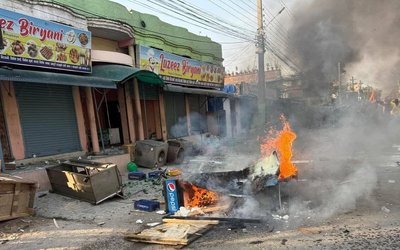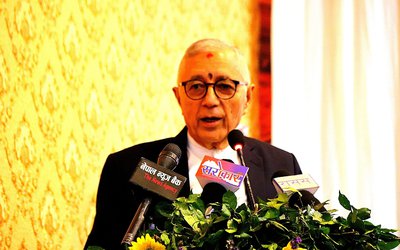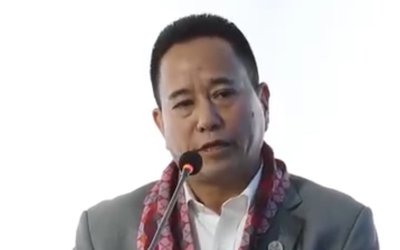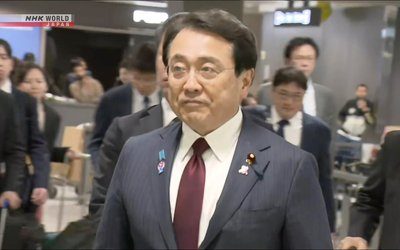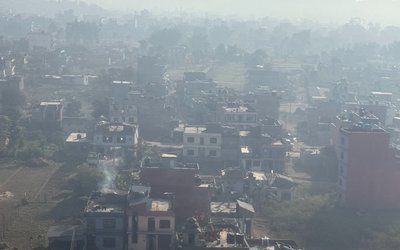
Indian prime minister Narendra Modi reached New Delhi after completing his two days official visit to Nepal issuing a joint press statement before his departure. Prime minister Sushil Koirala and ministers and high level government officials were present on the occasion.
Although all Nepalese prime ministers and head of the state visited Indian several times, Prime minister Modi was first to visit Nepal in the last 17 years.
Joint Press Statement
Joint Press Statement on the Official Visit of the Prime Minister of India, His Excellency Shri Narendra Modi, to Nepal (August 3-4, 2014)
The Prime Minister of India, His Excellency Shri Narendra Modi paid an official visit to Nepal from August 3-4, 2014 at the invitation of the Prime Minister of Nepal, Rt. Hon'ble Mr. Sushil Koirala. The Prime Minister of India was accompanied by Shri Ajit Doval, National Security Advisor (NSA), Ms. Sujatha Singh, Foreign Secretary and a delegation comprising senior officials of the Government of India and media. The Prime Minister of India was received at the airport by the Prime Minister of Nepal and was extended a ceremonial welcome.
2. The Prime Minister of India called on the Rt. Hon'ble President of Nepal, Dr. Ram Baran Yadav. The Rt. Hon'ble President hosted a luncheon in honour of the Prime Minister of India.
3. The Prime Minister of India addressed the Constituent Assembly and Legislature Parliament of Nepal and prior to the address, had a meeting with the Chairman of the Constituent Assembly, Rt. Hon'ble Subhas Chandra Nembang.
4. The Minister for Foreign Affairs, Hon’ble Mahendra Bahadur Pandey, Leader of the Main Opposition Party in the Legislature Parliament, Hon'ble Pushpa Kamal Dahal 'Prachanda', Chairman of the Communist Party of Nepal (UML), Hon'ble KP Sharma Oli, Hon'ble Mr. Sher Bahadur Deuba, Former Prime Minister of Nepal, Hon'ble Mr. Ram Chandra Poudel, Vice President of Nepali Congress, other political leaders including those from the Nepali Congress and Madheshi parties and leaders of the Nepalese business community called on the Prime Minister of India.
5. The Prime Minister of India had a meeting with the Prime Minister of Nepal followed by delegation level talks. These talks were held in an atmosphere of utmost warmth and cordiality and were marked by deep friendship and understanding which characterize the close relations between the two countries. The Prime Minister of Nepal hosted a banquet in honour of the Prime Minister of India.
6. The two Prime Ministers expressed satisfaction over the excellent state of Nepal-India relations that encompass a broad spectrum of political, economic, social and cultural ties that are deep-rooted at both government and peoples' levels. The two Prime Ministers also underlined the need to further explore ways to enhance sub-regional cooperation particularly in the areas of trade, transit, connectivity and hydropower. They underlined that the high level visits are vital for greater momentum to the close and cordial ties between the two countries. The Prime Minister of Nepal appreciated the enhanced focus and priority given by the new Government of India on relations with neighbouring countries, as manifested in, among others, the invitation to the SAARC leaders to attend the swearing-in ceremony of the new Prime Minister on May 26. This provided a unique opportunity for meaningful dialogue at the political level as well as for advancing regional cooperation under the framework of SAARC.
7. The Prime Minister of Nepal stated that Nepal has focused its attention on drafting a new constitution through the Constituent Assembly, which will lead the country to greater stability and prosperity. He shared Nepal's vision of graduating from the status of least developed country by 2022. The Prime Minister of India conveyed best wishes of the Government and people of India to the Nepalese leadership and people for their resolve and commitment to promulgate the new constitution early next year.
8. Both Prime Ministers recalled with pleasure the democratic elections held in both countries in the past one year with record participation of people and expressed satisfaction over these successes that reflect people's trust in democratic values and practices. They underlined the indispensability of democratic institutions for peace, stability and development. They also underlined that the Governments on both sides command strong mandate of their respective peoples providing historic opportunities to advance bilateral relations to a new height in practical and pragmatic manner to generate tangible benefits for the peoples of both countries.
9. The two Prime Ministers noted with satisfaction the reactivation of Nepal India Joint Commission at the level of the Foreign Ministers and welcomed the outcomes of the third meeting held in Kathmandu from July 25-26, 2014.
10. The Prime Ministers directed that all bilateral institutional mechanisms be convened regularly and their decisions be implemented expeditiously.
11. The two Prime Ministers agreed to review, adjust and update the Treaty of Peace and Friendship of 1950 and other bilateral agreements. They welcomed the decision of the Joint Commission to direct the Foreign Secretaries of the two countries to meet and discuss specific proposal to revise the Treaty of Peace and Friendship of 1950, which the Government of Nepal agreed to provide at the earliest. Both sides agreed that the revised Treaty should better reflect the current realities and aim to further consolidate and expand the multifaceted and deep rooted relationships in a forward looking manner.
12. The two Prime Ministers also underlined the need to resolve pending Nepal-India boundary issues once and for all. They welcomed the formation of the Boundary Working Group (BWG) to undertake the construction, restoration and repair of boundary pillars including clearance of 'Noman's land' and other technical tasks. They also welcomed the Joint Commission's decision to direct the Foreign Secretaries to work on the outstanding boundary issues, including Kalapani and Susta receiving required technical inputs from the BWG as necessary. The Indian side stressed on early signing of the agreed and initialed strip maps of about 98% of the boundary. The Nepalese side expressed its desire to resolve all outstanding boundary issues.
13. The two Prime Ministers welcomed the decision to establish an Eminent Persons Group on Nepal-India Relations (EPG-NIR) to look into the totality of Nepal-India relations from independent, non-governmental perspectives and suggest measures to further expand and consolidate the close and multifaceted relations between the two countries. They directed to expedite the formation of the EPG-NIR as per the agreed terms of reference.
14. Both Prime Ministers noted with satisfaction the excellent cooperation on security related matters and directed the competent authorities on both sides to make sure that the open border, which has facilitated movements of people on both sides of the border and has been a unique feature of Nepal-India bilateral relations, is not misused by unscrupulous elements posing security threats to either side. It was assured that Nepal and India will not allow their territory to be used against each other. The two Prime Ministers directed the concerned officials to expedite the signing of MoU on Police Academy. Both sides agreed to finalize the texts of Extradition Treaty and MLAT at an early date.
15. The Government of India announced a soft credit line of US$ 1 billion for the execution of infrastructure development and energy projects as identified and prioritized by the Government of Nepal.
16. The Prime Minister of India also visited Pashupatinath Temple and gifted 2500 kgs. of sandalwood to the Pashupatinath Temple Authority. The Government of India also informed that the construction of Pashupatinath Temple Dharamshala will be commenced soon through GoI grant assistance. The Government of India offered to assist in the conservation and restoration of old monuments in the Pashupatinath Complex as well as in providing sanitation and hygiene facility in the Pashupatinath Complex.
17. The Government of India also offered assistance for development of Janakpur, Baraha Chhetra and Lumbini, including linking Lumbini with the Buddhist circuit of India, based on specific proposals from Government of Nepal.
18. The Government of India announced enhancement of ITEC and Colombo Plan slots from 180 to 250 for Nepalese students and experts to study in various Indian institutions. The Government of India also offered short courses cum exposure visits for the Nepalese undergraduate students in the leading universities of India namely Banaras, Kolkata and Delhi University under Nepal-Bharat Maitri Shiksha Karyakram.
19. The two Prime Ministers witnessed the signing of the Exchange of Letters regarding Terms of Reference of the Pancheshwar Development Authority. They agreed that the two Governments would set up the Authority within 6 months and finalise the DPR of Pancheshwar Development Project and begin implementation of the Project within one year. The two sides also signed MoUs on Cooperation in the Goitre Control, and on Cooperation between Doordarshan and the Nepal Television.
20. The two Prime Ministers directed the concerned authorities to conclude negotiations within 45 days on the Project Development Agreement (PDA) between the Investment Board of Nepal and GMR Group of India for the development of Upper Karnali hydropower project. They also directed the concerned authorities to conclude negotiations on the agreement on trade in power sector within 45 days. They expressed desire for early conclusion of other three PDAs namely Arun III, Upper Marsyangdi and Tamakoshi III. They emphasized that development of projects of this size will be a major catalyst for the development of Nepal’s enormous hydropower potential.
21. At the request of the Nepalese side, the Indian side assured to assist the construction of a multilane motorable bridge over Mahakali River at Mahendranagar, which will allow traffic along the East West Highway to cross over the Mahakali River and establish a vital trade and transit linkage of far western region of Nepal with Indian cities of Uttar Pradesh, Delhi and Uttarakhand. The Indian side also conveyed to consider construction of motorable bridges at the border points at Jhulaghat and Darchula.
22. The Government of Nepal requested for assistance to complete the eastern sector of Mid Hill Highway, namely (Chiwabhanjyang-Ganeshchowk, 61 km, Jorsal-Tamor-Sankranti, 35 km, Sankranti-Myanglung, 68 km, Bhojpur-Diktel, 88 km, Haleshi-Hilepani 40 km, Ghurmi-Khurkot, 60 km). The Government of India agreed to consider the request positively.
23. The Two Prime Ministers expressed satisfaction over the ongoing defense cooperation. In this context, the Nepalese side requested the Prime Minister of India for waiver of the dues outstanding as on date owned by the Government of Nepal to the Government of India on account of defense purchases.
24. The Prime Ministers expressed concern over the slow pace of implementation of several projects under bilateral economic cooperation and directed competent officials to implement ongoing as well as the future projects expeditiously.
25. The Two Prime Ministers directed the competent authorities to expedite the construction of Postal roads and feeder roads (Terai roads) and complete the phase I expeditiously. They also directed to commence phase II within a year. The Indian side agreed to consider the Government of Nepal's request to implement the phase II projects by the Nepalese side with the Government of India's financial assistance.
26. The two Prime Ministers directed to work for the finalization and signing of the revised Rail Service Agreement, Motor Vehicle Agreement, Letter of Exchanges on Trade and Transit and ratification of BIPPA.
27. The two Prime Ministers also directed competent officials to expedite construction of cross border railway at all five agreed border points and the four Integrated Check Posts (ICPs) which will facilitate cross border trade and transit as well as Nepal's export to and import from third countries.
28. The Nepalese side requested and the Indian side agreed to take up the project for the construction of Raxaul-Amlekhgunj petroleum pipeline in the first phase and extend it to Kathmandu in the next phase to facilitate the transport of petroleum products.
29. The Nepalese side highlighted the trade deficit it is facing vis a vis its trade with India and suggested measures to address this deficit through increased Indian FDI, relaxation of non-tariff measures including SPS standards for agro products, support in product development, relaxation of Rules of Origin requirement for duty free access of Nepalese products, and mutual recognition of standards, conformity assessment and accreditation. The Nepalese side stressed that the countervailing duty (CVD) being levied by the Indian authorities on Nepalese exports including readymade garments, copper, brass utensils, Kattha and other products have had negative impacts on key Nepalese exports to India and requested the Indian side to remove it. The Nepalese side also requested to remove Quantitative Restrictions (QRs) on the four Nepalese export products namely Vegetable fats, copper products, Acrylic Yarn and Zinc Oxide. The Indian side assured to consider the requests by the Nepalese side. The Indian side also reiterated that problem of trade deficit could be best bridged by development of hydropower in Nepal and export of surplus power to India.
30. Recognizing the vital importance of transit rights of Nepal, the two Prime Ministers agreed to take further measures in the spirit of the Treaty of Transit, to simplify transit procedures and facilitate expeditious movement of traffic in transit. They directed to finalize and implement transshipment modalities at the earliest.
31. The Nepalese side requested India to allow three additional air entry points at Janakpur, Bhairahawa and Nepalgunj, and cross border direct routes to facilitate direct flights between regional airports Pokhara-Bhirahawa-Lucknow as this would save time and cost for air travelers and also improve air connectivity between India and Nepal. The two Prime Ministers directed the concerned authorities to meet within 6 months and resolve this issue and similar issues pertaining to the Air Services Agreement.
32. The two Prime Ministers directed the competent authorities to expedite the works related to the development of cross border transmission lines as agreed in the Joint Commission.
33. At the request of the Nepalese side, the Government of India agreed to consider to undertake the rehabilitation of Koshi Pump Canal and Koshi Western Canal System and rehabilitation of West Gandak Canal System with a Lift System to irrigate additional Nepalese land. The Nepalese side will communicate the details of the projects.
34. The Prime Minister of India expressed condolences for the human suffering and loss of lives and properties caused by the massive landslide at Sindhupalchowk district in Nepal this week. Both sides agreed to strengthen coordination and consultation to deal with the problem of floods and inundation.
35. The Prime Minister of India extended invitation to Prime Minister of Nepal to pay an official visit to India at an early mutually convenient date. The Prime Minister of Nepal accepted the invitation. The date will be finalized and communicated through diplomatic channel.
Kathmandu,
August 4, 2014
- NEPAL-THAILAND: Joint Business Council
- Apr 13, 2025
- BIMSTEC SUMMIT: Nepal’s Stand
- Apr 11, 2025
- IME GROUP: Expands Into Paper Industry
- Mar 24, 2025
- CPN UML: Instigated By India
- Mar 23, 2025
- ADB’S CHIEF ECONOMIST: Nepal Reduces Poverty
- Mar 11, 2025



